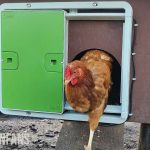10 Reasons Why You Should Keep A Jersey Giant

Jersey Giants are one of the largest purebred chicken breeds in the world, which can make you think they’re not suitable as backyard chickens when having small children. Nothing could be less true! Jersey Giants are, besides their largeness, sweet, docile, calm, great egg layers, and an excellent addition to any backyard flock.
We’ll give you 10 excellent reasons why the Jersey Giant is a chicken breed to consider.
Let’s start with some key takeaways to describe the Jersey Giant breed:
- Jersey Giant hens lay up to 200 eggs per year
- American dual-purpose breed
- One of the largest purebred chicken breed in the world (no hybrid)
- Friendly and docile
| Eggs | 150 – 200 eggs per year |
| Egg Color | Brown |
| Egg Size | Large |
| Weight | 10 – 13 lbs |
| Hardiness | Cold |
| Temperament | Friendly and docile |
| Beginner-friendly | Yes |
| Color | Three recognized colors |
Reasons to add a Jersey Giant to your flock
- Beautiful Birds
- Beginner-friendly
- Excellent pet chickens
- Good egg-layers
- Dual-purpose breed
- Docile, not flighty
- Easy to keep with other breeds
- Cold-hardy Winter layers
- Predator proof
- Special breed
And obviously, there are some things to keep in mind when keeping Jersey Giants. We’ll also address a few important issues to remember before running off to the hatchery.
1. Beautiful birds
Jersey Giants are an amazing-looking breed. They look enormous, as they were originally bred to replace the turkey, and are often the same size. The Jersey Giant was developed as a large dual-purpose breed by cross-breeding Black Javas, Black Langshans, and Dark Brahmas.
They come in three color varieties, Black, White, and Blue, whereas Black is the most popular color. That’s why we added this breed to our ‘Beautiful Black Chicken Breeds‘ list.
Black Jersey Giants have a green sheen over their plumage, which makes them look like absolute superstars.

The breed is fairly common in the US but uncommon in Europe and other parts of the world. The Jersey Giant is a great addition to your flock if you’re looking for a chicken breed to show off on social media, especially if you’re targeting an audience outside the US.
2. Beginner-Friendly
Jersey Giants are a healthy breed with no special requirements other than food, water, and shelter. They’re hardy birds that do well in cold weather environments. But, because of their large size, there are some things to keep in mind when adding a Jersey Giant to your flock:
- Require bigger living areas, both outside and inside the coop, and need larger nesting boxes. Provide at least 14″x14″x14″ for the nesting boxes; you can even go up to 20 inches in height.
- Lower roosting perches. They can hurt themselves by jumping off the perch if it’s too high because of their weight. Roosting perches should be a maximum of 1,5 feet above the ground.
- They’re great foragers, provide them with plenty of outside space to roam around, and keep them happy and healthy.
- They don’t stand heat very well. Always keep them cool during warm summer months, especially during heat waves.
3. Excellent pet chickens
As they look massive and impressive, it may come as a surprise Jersey Giants can be great pet chickens. They have calm and friendly personalities and are great to keep with small children running around. When trained from a young age, you can teach them to do tricks, pet and hand feed them.

But, because of their massive size, they’re not suitable to be picked up and held as lap chickens, especially not by small children.
This is why you may consider the Bantam variety of the Jersey Giant. It has all the advantages of the large fowl but comes in a miniature version. Bantam Jersey giants weigh between 2.2 and 2.5 pounds.
4. Good Egg-Layers
Many giant chicken breeds aren’t the best egg layers, but the Jersey Giant is an exception to the rule. They lay between 150 – 200 eggs per year, between 3 and 5 eggs per week. All eggs are large in size, and colors can vary between cream and dark brown.
Jersey Giants are not especially known as broody birds; some strains are broody, some not. It’s best to inform your local hatchery about the broodiness of their birds. If you’re not planning on hatching eggs, broodiness is something to keep in mind, as it will temporarily stop egg production.
Due to their massive weight, some Jersey Giant hens crush their eggs during brooding. If you want to prevent this from happening, it’s best to use an incubator.
The hatching process of Jersey Giants takes up to 1 or 2 days longer than other breeds. So keep in mind to leave the eggs for at least 25 days in the incubator to be on the safe side.
5. Dual-purpose breed
Let’s go back in history for a brief moment. The Jersey Giant was developed in the last decades of the 19th century. The initial intention was to create a breed that could eventually replace the turkey as a premium meat bird. Today, the Jersey Giant is still kept as both a meat and egg bird and is perfect for chicken keepers living self-sustainable lives.

All Jersey Giant chickens are ready for harvest at around 9 months of age, which is later than other meat birds. By then, they’d reached their adult weight of 13 pounds for roosters and 10 pounds for hens. One Jersey Giant chicken can feed a family of four without any problems.
One thing to remember is that Jersey Giants need a lot of food to reach their adult size; that’s why this breed is less interesting for the meat industry. A normal-sized chicken eats around 3.5-4 ounces daily, while a Jersey Giant doubles that amount by eating up to 7 ounces of chicken feed daily.
6. Docile, not flighty
Jersey Giants are docile and calm chickens, which comes in handy if you don’t want them to escape into your neighbors’ backyard. They love to roam and free-range, but if they’re given plenty of space to stretch their legs, they’ll be fine kept in confinement.
Because of their body weight and size, they can’t jump or fly very high. They can even hurt themselves by jumping off a roosting perch or branch, as their legs need to carry the body mass.
They’re a great pet to keep in a suburban neighborhood, but remember that some Jersey Giants can be a bit on the loud side. This is not the case in all birds; most are not louder than other breeds, but quieter breeds are available if you’re worried about complaints from your neighbors.
7. Easy to keep with other breeds
Jersey Giants are a great addition to any backyard flock, even if you already have other chicken breeds. They’re not known to be aggressive or overly assertive, and they’ll get along with most other chickens. Because of their size, they’ll probably be high in the pecking order, but as a friendly breed.

This breed integrates well in existing flocks, with all different birds. It’s best to keep them with other ‘gentle giants’ like Orpingtons or Australorps. But they get along with other breeds: Leghorns, Marans, and even Silkies or Frizzle chickens.
But always ensure every bird in your flock has plenty of personal space. A lack of space can cause problems like aggressive behavior, feather pecking, and health issues.
8. Cold-hardy Winter layers
Jersey Giants are known to be cold-hardy birds and do well in harsh environments. Like all chickens, they stand cold temperatures better than hot ones. The best temperature for chickens is around 75 degrees Fahrenheit (24°C) or below.
Ambient temperatures of 85 degrees Fahrenheit (30°C) and more impact chickens negatively. Always take precautions when a heat wave or any other kind of extreme weather is coming.
Due to their cold hardiness, Jersey Giants keep laying during winter, although egg production may slow down. You’ll enjoy their fresh egg all year round!
9. Predator proof
Of course, Jersey giants aren’t invisible to predators or not even uncatchable. But because of their large size, they defend themselves from smaller predators well. They will fight attackers, especially large roosters who are known to defend their flock.
Be aware that free-ranging your chickens comes with dangers. They’ll be out in the open, vulnerable to predators. As most predators attack at nighttime, locking your chickens up in their coop is important to keep them safe.
10. Special breed
There is something truly amazing about the Jersey Giant; They’re one of the world’s largest purebred chickens and known as one of the world’s biggest chicken breeds. Their extraordinary looks make them excellent backyard chickens and maybe make you consider breeding with the breed.
If you’re looking for a chicken breed that’s versatile, sweet, unique, and useful in many ways, the Jersey Giant is the right breed for you.
Things to keep in mind when keeping a Jersey Giant
We’ve addressed a long list of pros concerning keeping a Jersey Giant, but there are some things to keep in mind when keeping this unique breed.
- Need lots of inside and outside space
- Bigger nesting boxes
- Lower the roosting perch to max 1.5 ft
- Need more food than normal-sized breeds
- Can be noisy
- Take more time to mature
- Their legs are vulnerable because of their large body weight
Summary
Jersey Giants are one of the world’s largest purebred chicken breeds. Although they look massive and impressive, they’re a great addition to any backyard flock due to their friendly nature, good egg-laying skills, and docile personality. They’re a dual-purpose breed, so they can be kept for both meat and egg production.
Because of their size, they do need more outside and inside space and are preferably free-ranged. Jersey Giants lay up to 200 large eggs yearly, all tinted to brown in color.
To learn more about chicken breeds, check out our ‘Chicken Breeds Page‘ to see every specific breed we address. Or go to our listicle breed summary on ‘The Classroom‘, or, if you’re unsure where to start, take a look at our ‘Chicken Breeds: Ultimate Beginners Guide‘.
Related Questions
A Jersey Giant is an American chicken breed and one of the largest purebred chicken breeds in the world. They were created by crossing a Black Langshan, a Black Java and a Dark Brahma.
Jersey Giant hens lay up to 200 eggs yearly, up to 5 per week. All eggs are brown and large-sized.
Jersey Giants cost around $4 for an unsexed chick, $5 for a female, and $3 for a male.
Jersey Giants are among the biggest chicken breeds in the world. Roosters weigh around 13-14 pounds, and hens around 10-11 pounds.
Credits Featured Image: @adriennesmithartist (IG)






















